Austin A30 (1955)
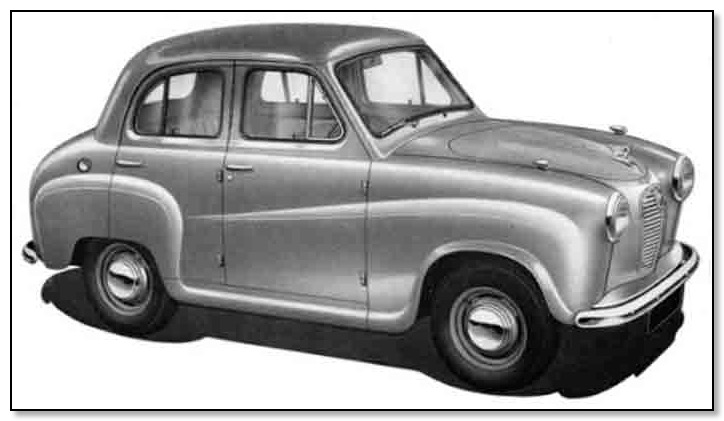
The Austin A30 Seven two-door saloon is the second cheapest car on the home market and the lowest priced car of post-war design. Unhappily for the vast number of those whom Civil servants would doubtless call marginal motorists its basic price of £335 carries purchase tax to the extent of £140 14s. 2d, which brings up its total price to £475 14s. 2d.
For this sum the motorist obtains a thoroughly roadworthy vehicle which combines a lively performance with an economical consumption of petrol - the makers claim more than 50 m.p.g. at 30 m.p.h. and a maximum speed in the upper sixties, From the driving seat the view forward is unusual because the full width of the car is shown by the high front wings with small parking lights mounted on top. The Austin Seven is therefore particularly suitable for the learner driver, while the experienced motorist appreciates being able to see for himself whether the sidelights are working.
Light Switch On Steering Arm
The switch for the lights and dipping the headlamps is mounted on an arm attached to the steering column, a sensible arrangement which has been used on some Continental cars for many years and which ought to be copied more widely, for it saves the driver having to lean forward and feel for a switch on the dashboard. Another excellent feature is the, " courtesy " light under the dashboard, which comes on automatically when one of the doors is opened.
The other switches and instruments are grouped in the centre of the facia, a layout which simplifies the production of left-hand drive models for export, but which is not ideal from the driving point of view. Instruments in front of the driver can be glanced at with less effort - an important advantage in heavy traffic. Many drivers would prefer a plain circular speedometer dial to the oddly shaped dial provided with its uneven spacing of the figures. Above the instruments is the switch and tell-tale light for the traffic indicators, which are of the semaphore type and are not self-cancelling.
Separate Fronts Seats
The separate front seats are comfortable for long journeys, the only criticism of the driving position being that the leather strap for shutting the door gets bent upwards by the driver's arm and is an unnecessary source of irritation. The effective width of the Tear seat is somewhat restricted by the wheel arches, but two adults can be carried in reasonable comfort. The headroom, on the other hand, is hardly adequate. The front windows slide up and down and have pivoting ventilators; the rear windows are fixed. There is a useful parcel shelf under the dash running the full width of the car, and the luggage boot is of commendable dimensions.
The Austin Seven is a pleasant car to drive. With a smooth clutch and a simple gear change with the central gear lever it can be taken through thick traffic with the minimum of effort, although on the car tested it was sometimes difficult to engage second gear, which is normally used for starting, when getting away from rest. Its compact size and light steering make it one of the easiest cars to park, and altogether it would be hard to find a more suitable car for city driving.
This is not to suggest that the A30 is not equally at home on the open road. Its excellent top gear acceleration was shown when it reached a speedometer reading of 52 m.p.h. in a quarter of a mile after leaving a built-up area, and it climbed Old Dashwood Hill in top gear at an indicated 19 m.p.h. (by changing down at 30 the hill was surmounted at 35 m.p.h.). The car cruised willingly with the speedometer needle swinging between 55 and 60 m.p.h. As with all row priced cars, there was a good deal of noise when-travelling fast.
The speedometer registered 30 m.p.h. at an actual 27 m.p.h. and 50 m.p,h. at an actual 46 m.p.h. At higher speeds the swinging speedometer needle made checking difficult. The steering is extraordinarily light and direct in action, but the lock is not as good as might be expected in a car of such dimensions. Perhaps the best feature of the car, apart from its lively and economical engine, is the springing, which provides remarkably smooth and comfortable on roads of widely varying surface. The car was notably steady on comers.
Brief Specification. Four-cylinder engine, 803., 28 b.h.p. at 4,800 r.p.m. Compression ratio, 7.2 to 1. Four-speed gearbox, 4.875 to 1 top gear. Tyres, 5.20 by 13. Tank, 5.8 gallons. Wheelbase, 6ft. 7.5in. Length, 11ft. 4.8in. Width, 4ft. 7.2in. Height, 4ft. 11.3in. Ground clearance, 6.8in. Turning circle, 35ft. Weight, with fuel, 14.3cwt. Price: basic, £335; purchase tax, £140. 14s. 2d. Total, £475. 14s. 2d.
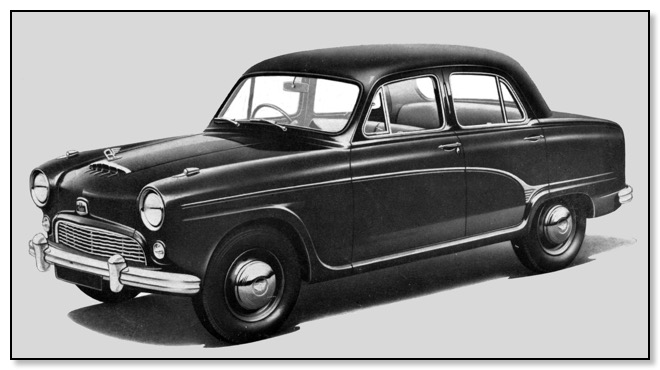
28 June 1955
Austin Westminster
One way of describing the progress made in motor car design is to say that the family car of to-day is as fast, if not faster, than the sports car of a few years ago.
Judged.by this criterion, the Austin Westminster saloon is in the forefront of medium sized family cars, for its maximum speed is in the region of 90 m.ph. and it will cruise at 75 m.p.b. with only a light foot on the accelerator pedal. The comparison is all the more pronounced because the Westminster, although a good looking car, is by no means racy in appearance.
The lines of a car are essentially a matter of personal taste, and, to the writer, this latest Austin is a welcome break from a series of cars that lacked attraction in this respect. On the de luxe model tested, the separate front seats, which can be aligned to accommodate an extra passenger, had individual folding armrests on each side of the driver and passenger and provided a combined width of 4ft. 2in.
Sitting High
The driving position is comfortable for long journeys, the driver sitting fairly high, with the wheel not too close, and being to see both the two front mudguards and side lights. These lights have the great merit of showing the driver without question whether they are working or not, as was customary on earlier cars. The front seats slide just over 4in., and when right back allow 8in. knee-room for the rear passengers. The rear seat is 4ft. 6in. wide, and has a centre armrest.
The two instrument dials are well placed in front of the driver, and have neat, easily read white figures on a black background. The gear lever on the steering column has a transparent plastic knob containing a red diagram of the gear change, which is much easier to operate than on previous models. The pistol-grip hand brake is placed alongside the steering column.
There is a shelf under the dashboard running the full width of the car, and this space is not obstructed when a radio is fitted., There is also a glove locker on the passenger's side, with a lid that opens horizontally and can therefore be used as a picnic table. On the de luxe model the lid can be locked.
Extra Items
The heater worked well, both for cold and hot air. Other extra items, in addition to the heater, of the de luxe model are seat facings of hide (a two-colour scheme of beige and green on the car tested), carpets instead of rubber mats, and an electric clock. Details of the body which are particularly praiseworthy are the wide front doors, which made the car exceptionally easy to get into, and swivelling quarter-lights on all windows.
The luggage boot is narrower than usual but is also deeper, a more sensible shape than the wider and shallower type normally provided. The spare wheel is in a separate cradle underneath, and is lowered by means of the starting handle. The flashing traffic indicators are separate from the side and rear lights and have amber glass. A word must be said about the door locking arrangements. Both the front doors have key locks and can also be locked by moving the inside handles forward before slamming the doors. This is an admirable system for the driver parking in a hurry, but it also means that the driver can lock himself out of the car if he leaves the ignition key inside. An excellent feature for the family man is that the rear doors have a separate locking device designed to prevent children from opening them accidentally.
On the road the car has a flexible performance, throttling down to 10 m.ph. in top gear and accelerating smoothly. The engine makes a powerful drumming sound when speeded up at a standstill, but this is less noticeable when accelerating hard in motion. Leaving a built-up area. the car reached a speedometer reading of 61 m.p.h. in a quarter of a mile. Old Dashwood Hill was surmounted at 40 m.p.h. in two gear. Checked by stopwatch, the speedometer was virtually accurate at 30 m.p.h. and only fractionally at 60 m.p.h.
The steering is light and accurate, with very little slack motion in the whee, and the springing is firm enough to give the car good roadholding at the high speeds it can reach. The car tested had developed some squeaks and other noises underneath. A useful detail of the standard equipment is a "pencil" of paint for touching up scratches in the bodywork. Altogether, the Austin Westminster is a medium size car with an exceptional road performance, selling at a price which should enable it to complete on more than level terms with the best of similar models made abroad.
Brief Specification: Six-cylinder engine, 2,639 c.c., 85 b.h.p. at 4,000 r.p.m. Compression ratio, 7.3 to one. Four-speed gearbox, top gear ratio 3.91 to one. Tires, 6.40 by 15. 12.5 gallon tank. Wheelbase, 8ft. 7.8in. Length, 14ft. 2.3 in. Width, 5ft. 4in. Height, 5ft., 3.9in. Ground clearance. 7.4in. Turning circle, 36ft.
Basic price: Standard saloon £558, purchase tax £233 12s. 6d.; total £791 12s. 6d. De Luxe saloon £588, purchase tax £246 2s. 6d. ; total, £834 2s. 6d.
Austin Healey Road Test (1956)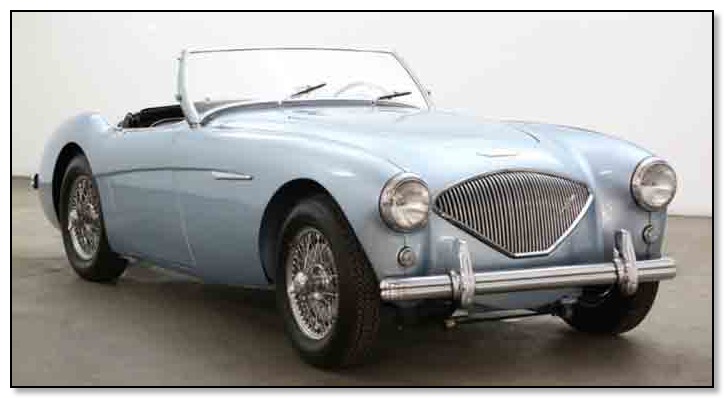
LHD version
A by no means insignificant contribution to the motor industry’s export trade has been made in recent, years by sports models, especially in the United States market. Although these cars attract buyers chiefly because of their high performance, they must also provide good value for money. There are a few cases of expensive models of a highly specialized character being sold, but only in small numbers; the really worthwhile market is for the moderately priced sports car which comes within a popular price bracket.
It follows that British sports cars would not have achieved their world-wide popularity unless, the big manufacturers had stepped in to produce them in, sufficient quality to keep down the price. One of the most successful of these quantity produced British sports cars is the Austin Healey 100, which was the result of a happy arrangement between an individual sports car manufacture, Mr. Donald Healey, and the Austin Motor Company. Mr. Healey has had distinguished career in competitive motoring, winning the Monte Carlo Rally in an Invicta in 1931 and since the war competing with success in the difficult Mille Miglia motor race in Italy and elsewhere in cars of his own manufacture.
Excellent Handing
The first Healey sports car was produced shortly after the war and was notable for its excellent handling, which was only to be expected from the experience of its manufacturer. Healey cars with Riley engines achieved many successes, and Mr. Healey later came to an agreement with the Nash Company to produce the Nash Healey sports car for the American market. Finally in 1952 he exhibited at the motor show an entirely new model with an Austin A90 four-cylinder engine and a two seater body of attractive shape. The show had not been in progress for many hours before Sir Leonard Lord announced that he had agreed to produce the car in quantity at the vast Austin factory.
This cooperation between an experienced competitive motorist and a large factory has produced a thoroughbred sports car at a price which has immensely broadened the scope of its sales. Since then the Austin-Healey 100 has achieved a weekly output of up to 200 cars, the bodies being made by Jensen Motors. Ltd., and fitted to the complete chassis at Longbridge. It was recently announced that 150 Austin Healey, sports cars were sold in California during January, and it is evident that the popularity of the car is being well sustained.
Abundant Power
The attraction of the Austin Healey 100, apart from its well proportioned lines, is immediately apparent on taking the wheel. Here is a car that has abundant power, that handles like a thoroughbred, and is at the same time flexible and restful to drive in thick traffic. For running in towns third gear is normally used, and in this gear a lazy driver can drop to a crawl and accelerate smartly without any coaxing of the accelerator pedal. In top gear the pick-up is remarkable, for a speedometer reading of 72 mph. was reached within the space of a quarter of a mile after leaving a built-up area. The sporting motorist would of course disdain such top-gear driving and would make full use of the gearbox with its excellent gear change.
The Austin Healey is equipped with the Laycock de Normanville overdrive on top and third gears, and this not only provides in effect six forward speeds but, more important, gives the car a high cruising speed without stressing the engine-at 70 mph., for example, the engine is turning over at 3,020 rpm., compared with 3,885 rpm. in normal top gear. The revolution counter bears a red mark at 4,800 rpm., which is the equivalent of 87 mph. in top gear (4.10 to one) and 111 mph. in overdrive (3.18 to one).
The road holding, steering and braking of the Austin Healey 100 are fully in keeping with its performance, the only slight criticism being a tendency of the brakes to squeal when applied at low speed. There is a fairly powerful boom from the exhaust, and with the hood up the car is naturally more noisy than a saloon. The hood and side screens are remarkably effective in keeping, out the rain, and with an extremely powerful heater the occupants of the Austin Healey can be as warm and snug in icy weather as motorists in many a family saloon.
Technique of Getting in
First, however, they have to get into the car, and this calls for a certain amount of personal flexibility. The correct technique is to lower oneself backwards on to the seat, and swing the legs inside afterwards, easy enough for the young but more difficult for the middle age. A more serious criticism is that there is little. distance between the head of a driver of medium build and one of the crossbars of the hood, a clearance which can be painfully reduced on occasions.
It seems a pity that in making the car an attractive overall shape with the hood up, it has been necessary to sacrifice the convenience of the occupants. A final criticism concerns the position of the handbrake, which is between the driver's seat and the transmission tunnel, where it is difficult to grasp with a gloved hand.
Brief Specification - Four-cylinder engine, 2,660 cc. Compression ratio, 7.5 to 1. Ninety bhp. at 4,000 rpm. Four-speed gearbox with overdrive in third and top, central lever. Ratios: 3.18 overdrive top, 4.10 top,, 4.24 overdrive third, 5.46 third, 7.85 second, 12.60 first. Tyres, 5.90 by 15. Twelve-gallon tank. Wheelbase, 7ft. 6in Length, 12ft. 7.5in. Width, 5fL 0.5in. Height over hood, 4ft. 1in. Ground clearance, 5.5in. Turning circle, 35ft. Weight, less petrol, 20.5cwt. Price: basic, £750 -7s purchase tax, £376-7s. Total, £1,126-7s
Austin A95 Saloon Westminster (1957)
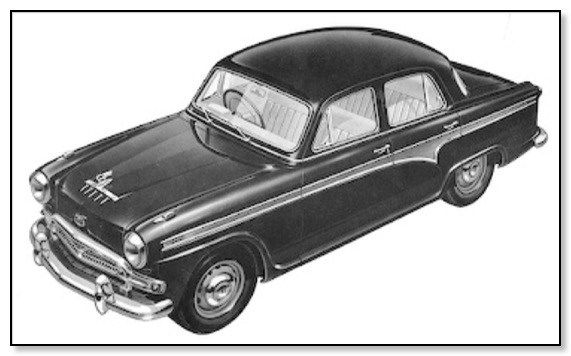
Although American motor manufacturers continue to make their engines bigger and more powerful (the larger of the new Edsel models has a 6.7-litre engine developing 345 bhp., British manufacturers are producing comfortable saloon cars which provide an adequate road performance with engines only about one-third as big as the American example quoted. The big American cars are more spacious and are capable of a much higher speed, but this is seldom used to the full.
This train of thought was provoked by a recent test of the Austin A95 Westminster saloon, which has a six-cylinder engine of a mere 2.6-litres capacity, carries a comfortable saloon body, and can reach a speed of about 90 mph. when the opportunity permits. The engine is the C type BMC. unit which in one form or another is also used in the Austin A105. the Morris Isis, the Wolseley 6/90, the Riley 2.6, and the Austin-Healey sports car, and it is clear that this standardization and consequent large-scale production has resulted in an engine of excellent quality and reliability.
Unfailing Power
At all times it gives the driver a satisfactory impression of unfailing power, accelerating well from low speeds and having something in reserve at the cruising speeds normally maintained on British roads. The car was also driven on the Continent, here the engine was equally satisfactory at the higher speeds achieved. Indeed, the A95 is a most comfortable car for a long journey, demanding little effort from the driver. This particularly noticeable on the car tested, which was fitted with the Borg-Warner automatic transmission. The calm and restful atmosphere created by the absence of manual gear changing permits the driver to concentrate on other aspects of driving technique, and by considerably reducing fatigue it undoubtedly contributes towards road safety.
The A95 is well sprung, although it was inclined to pitch on some indifferent roads abroad, and in general it holds the road very well. The brakes are powerful but squealed when stopping in traffic. The car tested had flush fitting separate front seats. These gave a comfortable and well supported driving position which was much appreciated on all-day drives, while the separate folding arm rests in each front seat gave an air of agreeable luxury. The squab of the back seat. however was insecurely, fastened and refused to stay in position. There is a useful shelf under the facia (which has a padded edge) running the full width of the car, and there is a shallow locker with a key on the passenger's side.
The absence of a shelf behind the rear seat was noticed, this being an asset which has come to be taken for granted on most cars and is missed all the more when it is lacking. The body was commendably free from rattles and squeaks. even when traversing poor surfaces. There were no leaks in the severest rainstorms and no irritating draughts from the doors or windows as are still found on too many cars. The Austin body has a pleasant external appearance, but the interior. although well finished, somehow lacks the “contemporary” smartness which undoubtedly appeals to many motorists in England as well as abroad.
Smooth Acceleration
With the kick-down gear change of the automatic transmission requiring little extra pressure, it was difficult to measure the top gear acceleration from 30 mph. limit, but a speedometer reading of 62 mph. was reached within a quarter of a mile. With the intermediate gear engaged the reading was 65 mph. the car having automatically changed into top gear at about 60mph. The gear changing speeds depend upon the pressure on the accelerator with a medium throttle opening the change from low to intermediate takes place at about 20 mph. and the change to top gear at about 45 mph. Checked by stopwatch the speedometer registered 30 mph. at 29 mph. and was virtually accurate at 60 m.p.h. the engine was inclined to run a high temperature in dense traffic blocks on a hot day, but this may have been a fault of the individual car. With its high standard of mechanical workmanship and its solid, comfortable, and well finished bodywork the Austin A95 de-luxe saloon is a highly competitive car at its basic selling price of £719, to which has to be added £360 17s. purchase tax. The Borg-Warner automatic gearbox costs an extra an extra £105 10s. plus £52 10s. purchase tax.
Brief Specification
Six cylinder engine, 2,639 c.c. Compression ratio, 8.25 to one, 92 bhp. at 4,500 r.p.m. Engine speed at 50 mph. in top gear, approximately 2,500 rpm. Standard three-speed automatic gearbox. Four-speed gearbox with or without overdrive available. Ratios: Top 3.91 to one direct, intermediate, 5.63 to one (minimum torque multiplication) to 12.08 to one maximum; low, 9.03 to one (minimum torque multiplication) to 19.39 to one maximum. Sixteen gallon tank. Tyres, 6.40-15. Wheelbase, 8ft. 9.8in. Length, 15ft. 0.8in. Width, 5ft. 4in. Height. 5ft. 2in. Ground clearance. 7in. Weight approximately 26.8cwt.
Price de-luxe saloon with automatic transmission as tested. basic, £824, plus £413 7s. Purchase tax; total, £l,237 7s.
Austin A55 Cambridge (1958)
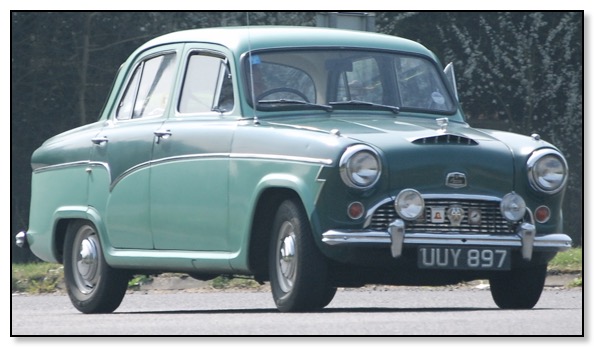
The Austin A.55 Cambridge saloon is a deservedly popular family car that is of particular interest because it illustrates the continuous development work carried on by British motor manufacturers. The model made its first appearance in 1948 when it was called the A.40 Devon and was one of the Austin company's brand new post-war design.
The original A.40 was a pioneer in developing the export trade to North America and it is no exaggeration to say that the subsequent success of the small British and foreign car there owes much to the spadework done by it in the first place. In 1952 the car was restyled as the A40 Somerset, and in 1954 a new model with a completely different body, was introduced in two versions-the A.40 Cambridge with 1.200cc. engine as before and the A.50 Cambridge with 1.500cc. engine. In 1956 the A.40 was dropped and early last year the present car, the A.55 Cambridge with a restyled body and seating, modified suspension and high compression B-type engine, was introduced.
Smart and Sensible
In its latest form the A.55 saloon is an excellent all-rounder, carrying a comfortable and quite roomy saloon body at speeds which many a driver of small sports cars a few years ago would have been proud to achieve and at the same time possessing an outward appearance that is a nice combination of smartness and sensible proportions. The front seats are separate and yet can be made flush fitting a commendable feature of Austins for many years. The rear seats are all the more comfortable because there is plenty of leg room. In fact no excuses have to be made for the passenger room provided by the A.55, the overall dimensions being probably the minimum for which this can be said.
It would be difficult to find a car with better accommodation for small articles, for there is a wide (but not too deep) shelf running the full width of the car underneath the facia, except for the space taken by the radio and there is a locker on the passenger's side. The finish is good. and the body was free from rattles, (the mileage registered was just over 5,000). The controls and instruments are well placed. except for the dipper switch which is too high and necessitates lifting the foot to operate it.
Cruising at 65 MPH.
The steering column gear change has been considerably improved and incorporates a strong spring to prevent the lower gears from being engaged accidentally. It is often difficult to engage first gear when starting from rest but the car gets away smoothly in second. A central lever is now obtainable to special order at an extra cost of £5 plus £2. 10s purchase tax for those who prefer to be in more direct touch with the gearbox. The car tested was the de-luxe model and was fitted with carpets in both front and rear compartments, side arm rests, twin sun visors, a locking glove box. bumper over-riders and a heater. The engine started immediately after a night in the open and warmed up very quickly thereby preventing the irritating habit of stalling in traffic during first few miles that still afflicts some cars.
Considering its dimensions. and the modest size of its engine the A.55 is surprisingly lively, other motorists will doubtless have noticed that the Cambridge is invariably driven at a good speed. leaving a 30 mph. speed limit in top gear it accelerated to 60 mph. within a quarter of a mile and would go on to cruise at between 63 and 70 m.p.h. Checked by a stopwatch the speedometer was found to be virtually, accurate both at 30 and 60 mph, a somewhat rare and very commendable feature. At speed there is a fairly pronounced hum which is not unpleasant but this might be reduced by extra soundproofing. The springing is exceptionally good and the car holds the road well on corners. With Strong brakes and accurate steering the driver enjoys his task and the overall effect is of a soundly designed and constructed car that should give good service.
Optional extras include radio, electric clock, Borg-Warner overdrive and Manumatic clutch
Brief Specifications:-
Four-cylinder engine, 1,489 cc. Compression ratio, 8.3 to 1. 51 bhp. at 4,250 rpm.
Engine speed at 50 mph. approximately 3,150 rpm.
Four-speed gearbox, 4.3 to I top. 6.51 to I third, 10.35 to I second, 16.98 to 1 first.
Cam and Peg steering.
Suspension: wishbones and coil springs, front: - semi-elliptic rear:- leaf-springs. 8.8gallon tank.
Wheelbase. 8ft 3.3in. Length. 13ft 10in. Width. 5ft. 1.5in. Height. 5ft. 0.3in. Ground clearance, 6in.
Turning circle, 37ft. 6in. Approximate weight, with fuel, 21.3cwt. Tyres. 5.90-13.
Price. de-luxe saloon as tested, £546, plus £274. 7s. purchase tax. Total £820 7s.
Standard saloon, £514, plus £258 7s. purchase tax, Total £772 7s
Austin A40 Farina (1959)
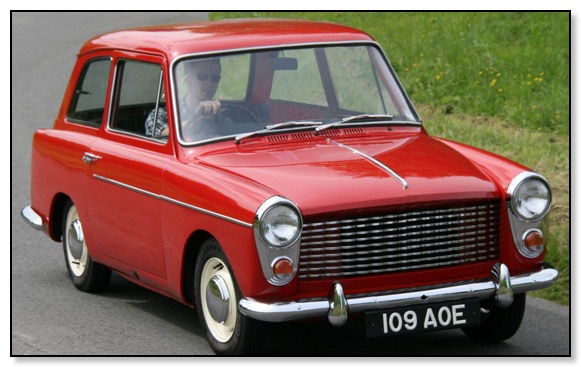
On its introduction last September, the new Austin A40 was something of a landmark in the history of the British Motor Corporation. For the first time the firm had gone outside their own resources for the design of the body, employing the famous Italian, Pinin Farina, not merely as a consultant behind the scenes but as a collaborator whose share in the product was widely publicized.
Most people would agree that the A.40 is one of the best body designs that has emerged from a British car factory, its chief virtue being a simplicity of line which has not been spoilt by any afterthoughts or additions.
Interior Layout
The A.40 is also unusual in the layout of the interior, for the back of the car combines some of the advantages of the estate car or station wagon. The word “ some " is used advisedly, because the A40 lacks the free access to the rear through a wide door or hinged sections, as in the ordinary estate car; instead, the wide rear window is fixed, and only the lower body panel is hinged. Again, the rear seat cannot be folded to fit flush with the floor of the luggage compartment, as can be done in an estate car. although the seat can be pulled forward to increase the carrying capacity below the waistline from 11.5 cu.ft. to 18.8 cu.ft.
This gives the A40 a distinct advantage over the small family saloon, especially as a vehicle for two people, in which form it is admirably suited to long tours with the maximum amount of baggage space. With the rear seat in its on normal position, two extra passengers can be carried quite comfortably, and there is still a fair amount of room for luggage behind in a space which is screened by a fabric cover. The angular shape of the body, with the roof line carried through farther towards the rear than is the case with an ordinary saloon. gives more headroom for the rear passengers.
The A.40 is, indeed, a very pleasant car to ride and travel in, because the large windows give a sense of spaciousness and freedom from constriction. The driving position is excellent, but the forward vision would be improved if the screen and front door pillars were not quite so thick. The wide rear windows make reversing easy, and the blind spots on each side, which can conceal a following vehicle or motor cyclist, are much smaller than usual The front windows slide up and down by hand a simple method which dispenses with window winding mechanism inside the doors and which therefore increases the width of the front compartment. The doors, incidentally are exceptionally wide (there is only one door each side) and more than the usual amount of care is necessary in opening them to avoid inconveniencing pedestrians on the nearside and passing cyclists on the offside. The rear windows (on the de luxe model) are hinged at the front to provide extra ventilation.
Cruising Speed
With its four-speed gearbox and A-type BMC engine, the A.40 has a lively performance and yet it is not a car that depends upon continual working of the gearlever. Top gear can be held as slowly as 10 mph., and on leaving a 30 mph. speed limit the car can reach 55 mph. within a quarter of a mile. Third gear is useful for overtaking and the A40 can exceed 50 mph. in this gear. The cruising speed can be anything up to 60 mph. or so, but there is a good deal of noise at the higher speeds and the average, owner would probably be content to keep the cruising speed down to 50 to 55 mph
First Class Brakes
The steering is not as light as might be expected when parking considering the small size of the car but it is light and positive at speed, and the car handles well on corners. The steering lock however is not as compact as it should be, the turning circle to the right being 35ft. The brakes are fist class being sweet and progressive under varying degrees of pedal pressure. Altogether the new Austin A40 is a most attractive little car both in style and performance.
Brief Specification
Four cylinder engine, 948 cc. Compression ratio. 8.3 toI. Power 34 bhp. at 4,750 rpm. Four-speed gearbox, synchromesh. on second. third,and top, Ratios: 4.55 to 1 top, 6.43 to 1third, 10.80 to I second, 16.51 to 1 first. Cam and peg steering. Lockheed brakes.Six-gallon tank, mechanical pump. Suspension (front), wishbones and coil springs(rear) half-elliptic leaf springs. Wheel-base 6ft, 11.5in. Length, 12ft. 0.3in. Width.4ft. 11.8in. Height, 4ft. 8.8in. Ground clearance, 6.3in. Turning circle. 35ft 3in.Weight with. fuel 15cwt. Tyres 5.20-13.Price. basic saloon. £450, plus £226 7s.Purchase tax. total £676 7s. De-luxe saloon,as tested. £458 -10s. plus £230 12s. purchase tax total £689 2s.
Austin A99 Westminster (1959)
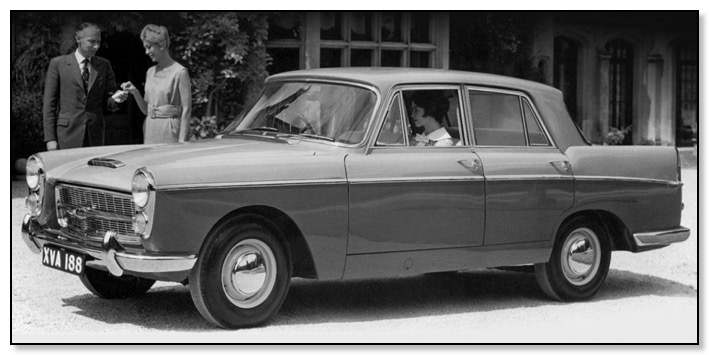
So much attention has been paid to the new B.M.C. baby cars that it is as l to recall that the corporation is also making large cars which, if not of the revolutionary design of the Austin Seven and Morris Mini-Minor, at any rate are of great credit to their makers.
Perhaps it would be more accurate to borrow the American term – compact- to describe the Austin A-99 Westminster, because although it is a full six-seater saloon with plenty of luggage space, it does not look a large car, nor does it fell like one to the driver. This is because he sits in a fairly upright position with a good view forward over the sloping bonnet and with the nearside mudguard as clearly visible as the offside. He therefore quickly learns to gauge the width of the car and can take it close to the verge of a narrow lane with confidence.
The windscreen, side windows, and the rear window are all of generous depth so that the driver has a good all-round view, and when reversing he can see through the rear window the fins which mark the extremities of the car. In passing, it might be mentioned that these fins suit the A.99 rather better than the B-series of B.M.C. cars which have the same body shape designed by Pinin Farina. The fact that the whole body is bigger may have something to do with it, and the fins do not seem to slope upwards towards the rear of the car so much as they do in the smaller models. The body can accommodate six people in reasonable comfort with adequate headroom and leg room, but a tall driver would wish that his seat could be adjusted farther back.
Inside Finish
The detail finish inside is good without incorporating the polished woodwork which is the hallmark of the higher quality British car and in the B.M.C. range is represented by the Austin’s sister car the Wolseley 6/99. The appearance of the facia panel is a considerable improvement on that of the previous larger Austin models, which were frankly somewhat hideous in this respect, and the A.99 has particularly pleasing instrument dials placed in front of the driver and containing all the indications that he requires.
A two-speed windscreen wiper, a windscreen washer and a heater are all fitted as standard equipment, indeed, the only optional extras are a radio and automatic transmission. There are swivelling ventilator windows in the rear windows as well as in front, an interesting point being that the front ventilator caused an acute draught round the driver's head whereas there was no draught at all if this ventilator was shut and the window lowered several inches. The controls and switches worked well and are all conveniently placed except the switch for the traffic indicators, which is on top of the steering column and forces the driver to take his hand off the steering wheel every time he wants to signal. The gear change can also be criticized for being rather awkward in action, especially through the gate. This is rather surprising because the car has only three forward gears, and reverse occupies the fourth position instead of having to be accommodated separately.
Overdrive
The A.99 has a completely different transmission from previous models in this category and consists of a three-speed gearbox with synchromesh on all gears (so that first gear can be engaged quietly without any precise speeding up of the engine) in conjunction with a semi-automatic overdrive which works in the following way. As soon as the car reaches a speed of 32 m.p.h. the overdrive is automatically engaged, and direct drive is re-engaged when the speed drops to 27 m.p.h. In addition, direct may be reengaged at any speed above 32 m.p.h. by means of a kick-down switch operated by fully depressing the accelerator pedal. The driver, therefore, has a good deal of control when the overdrive is operation, and he can cut it out completely by pushing in a lever at the bottom of the facia. This can only be done, however, when the engine is pulling.
Flexible Engine
These changes are so smoothly carried out that a driver new to the car, and not knowing how the overdrive works, would have some difficulty in deciding which gear he is in. The combination of overdrive second and normal second gear is very effective on a road with a certain amount of traffic because overdrive top and the kick-down engagement of normal second provides very rapid acceleration for overtaking other vehicles.
Since the car freewheels below 27 m.p.h. some care has to be taken in pressing the accelerator below this speed when using this second gear technique because of the abundant power available. Ideally it should be possible to engage or disengage by a simple switch instead or having to think about whether the engine is pulling or not. The freewheel probably helps to keep down the petrol consumption, as does the overdrive and altogether the economy of the Austin A99 will be considerably affected by the way in which it is driven. The test figure quoted by the makers is 17.3 m.p.g/ when the car is driven hard. The 3-litre engine is flexible and will drive the car smoothly at low speeds, while in second gear the speed can be reduced to a crawl.
On leaving a 30 m.p.h. speed limit the car reached an indicated speed of 68 m.p.h. in a quarter of a mile using direct top. The overdrive of 2.73 to 1 gives a very high cruising speed of 80 m.p.h. or more, while a speed of close on 100 m.p.h. is within the car’s capacity in direct top. At high speed on M1 the image in the road mirror became blurred through vibrations and deprived the driver of that rearward vision which is essential on motorways.
Smooth Braking
The A99 has Lockheed disc brakes in the front and drums at the rear, the smooth and unfailing braking power provided gives the driver a feeling of confidence that is seldom achieved with drum brakes only. There is a warning light on the dashboard which comes on if the servo-assistance to the brakes becomes inoperative. Altogether the Austin A99 Westminster is a thoroughly practical, comfortable six-seater saloon with a fine road performance selling at a very reasonable price.
Brief Specification
Engine: 6-cylinder. 2,912 c.c. 108 b.h.p. at 4,750 r.p.m. : compression ratio 8.3 : 1 twin S.U. carburettors. Twin electrical fuel pumps. 16 gallon tank. Three-speed synchromesh gearbox combined with overdrive. steering column lever. Ratios: Overdrive top 2.73 to 1. top 3.9, overdrive second 4.50, second 6.45. overdrive first, 12.09 to 1. Automatic gearbox optional extra. cam and peg steering. Lockheed brakes. disc front, drums rear. Suspension: coil springs front, semi-elliptic leaf springs rear. Tyres 7.00 -14. Dimensions: wheelbase 9ft. Length 15ft 7.5in. Width 5ft 8.5in Height 5ft. 0.5in. Unladen weight. 30.5 cwt. Turning circle. 38ft 9in. Ground clearance 6.3in. Price: £810. plus £339 purchase tax total £1,149.

